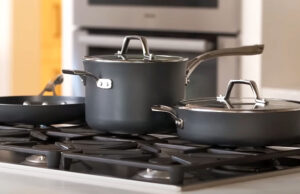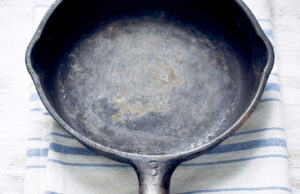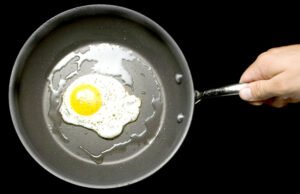As an Amazon Associate, I earn from qualifying purchases at no extra cost to you.
How to Start Frigidaire Dishwasher with Buttons on Top: Easy Steps
You just got your Frigidaire dishwasher with buttons on top and you’re ready to clean those dirty dishes. But the buttons confuse you a bit, and you’re not sure what to press first. Don’t worry, you’re not alone. I was in the same boat when I first used mine. The good news is, it’s actually very easy once you understand the steps. In this article, I’ll walk you through everything you need to do, from opening the door to starting the perfect wash. Let’s get your dishes sparkling clean.
Open the Dishwasher Door the Right Way
Before you can press any button, you need to open the door. The Frigidaire dishwasher with buttons on top has a top-control panel, which means the buttons are hidden until you open the door. Many people try to press the buttons while the door is closed and nothing happens. That’s because the controls are only active when the door is open slightly. So, the first thing you need to do is gently pull the handle at the top of the door. You’ll feel a soft click, and the door will open just enough to reveal the button panel.
When you see the buttons, take a moment to look at them. They’re usually labeled with words like ‘Normal’, ‘Heavy’, ‘Quick’, ‘Start’, and maybe even ‘Hi-Temp’ or ‘Delay’. Don’t worry if it looks like a lot. You don’t have to press all of them. Just a few of the right ones. The door must stay open a bit while you’re selecting your wash. If you close it too soon, the cycle won’t start.
Make sure there’s no water leaking or dripping. Check the edges of the dishwasher for leftover soap or food. Wipe that off so your door closes tight later. This helps your machine work better and keeps it safe.
Some models have a child lock or control lock. If your buttons don’t work, look for a small lock symbol. You may need to press and hold that button for 3 seconds to unlock the controls.
- Gently pull the door open until you see the control buttons
- Keep the door open while pressing your wash options
- Check for a lock symbol and unlock if needed
- Wipe the edge of the door if it has soap or water
Load the Dishwasher the Right Way
Before you start your Frigidaire dishwasher, you need to load it correctly. This step really matters because the way you place your dishes affects how clean they get. If plates block the spray arms or bowls nest together, your dishwasher may not clean well. So take your time while loading.
Start with the bottom rack. Place big items like dinner plates, pots, and pans on the bottom. Make sure they are standing up straight and not covering the spray arms. Do not let them touch each other too much. If things are stacked or leaning wrong, water won’t reach all the spots.
On the top rack, place cups, glasses, and smaller bowls. Tilt cups and glasses so water can drain off easily. Place plastic items on the top so they don’t melt. Avoid putting sharp knives upward. Lay them flat or point them down in the utensil basket.
The utensil basket is for your forks, spoons, and knives. Don’t toss them all in one space. Mix them up and keep handles down. That helps water reach every part and makes sure they don’t nest together.
Remove big food pieces before loading. You don’t have to scrub, just scrape off leftover food. Big chunks can block the filter and stop your dishwasher from working properly.
Don’t overload your dishwasher. If it’s too full, water won’t reach every item. Leave some space between items so water and detergent can do their job.
- Place big plates and pots on the bottom rack
- Put cups and plastic items on the top rack
- Use the utensil basket and mix forks and spoons
- Scrape off food but no need to rinse
- Leave space between dishes and don’t overload
Add the Right Dishwasher Detergent
Now that your dishes are loaded, it’s time to add detergent. Frigidaire dishwashers work best when you use the right kind and right amount of detergent. There are three main types you can use: powder, liquid, or pods.
If you’re using a detergent pod, this is the easiest. Just drop one pod in the detergent compartment. Make sure your hands are dry so the pod doesn’t stick or start melting early. Close the little lid of the compartment after you put it in.
For powder or liquid, pour it into the detergent dispenser. Look for the fill line and don’t go over it. Using too much detergent can leave soap spots on your dishes. Using too little might leave them dirty. A tablespoon or two is usually enough.
You may also see a spot for rinse aid. This is different from detergent. Rinse aid helps dry your dishes better and stops water spots. If your dishwasher has a rinse aid compartment, you can open the small cap and pour rinse aid in until it reaches the fill level.
Never use regular dish soap. It makes lots of foam and can cause leaks. Always use dishwasher detergent only.
- Use one pod or fill detergent to the line
- Add rinse aid if you want better drying
- Never use regular dish soap
- Keep the compartment closed after adding detergent
Choose the Wash Cycle You Need
This part is where many people get confused. Your Frigidaire dishwasher has different cycles because different dishes need different washes. You don’t have to know them all by heart, but understanding the basic ones helps.
Press the ‘Normal’ cycle for your everyday plates, cups, and bowls. This cycle is good for most loads and gives you clean dishes in about 2 hours. If your dishes are very dirty, or you cooked greasy food, press ‘Heavy’ instead. This one uses more water and time but gives a deeper clean.
If you’re in a hurry, use the ‘Quick’ or ‘1-Hour’ cycle. This washes your dishes faster but may not clean heavy food well. Good for lightly used plates and cups.
Some models have a ‘Top Rack Only’ button. This saves water by washing only the top rack. Use this when you only have a few cups or glasses to wash.
You may also see buttons like ‘Hi-Temp Wash’ or ‘Sanitize’. These use hotter water to kill germs and clean better. Press these if someone was sick or if you want extra clean dishes.
To choose the cycle, press the button gently once. A small light should turn on next to the cycle you picked.
- Press ‘Normal’ for most daily loads
- Press ‘Heavy’ for greasy or very dirty dishes
- Use ‘Quick’ if you need fast washing
- Try ‘Hi-Temp’ or ‘Sanitize’ for cleaner results
- A light will show which cycle is selected
Press the Start Button the Right Way
Now it’s time to actually begin the wash. This step is very easy, but if you don’t do it the right way, nothing will happen. After choosing your cycle, you need to press the ‘Start’ button. On most Frigidaire dishwashers, the button says ‘Start/Cancel’.
Press the ‘Start’ button once. Some models may need you to hold it for 2–3 seconds. When you press it, you might hear a soft sound or beep. That’s normal. It means the dishwasher is ready.
Now, close the door firmly. Don’t just push it slightly. You have to push it all the way until it clicks. Once the door is closed tight, the cycle should begin in a few seconds. You may hear water filling or spray arms moving. That means it’s working.
If the dishwasher does not start, open the door again and check if you really pressed the ‘Start’ button. You might also need to press it again and shut the door faster. Some models need the door to close within a few seconds after pressing ‘Start’.
- Press ‘Start’ or ‘Start/Cancel’ once
- Hold for 2–3 seconds if needed
- Close the door firmly until it clicks
- Listen for sounds to make sure it’s working
- Try again if it doesn’t start right away
Check for Lights and Sounds After Starting
Once your Frigidaire dishwasher starts, it will show some lights or make soft sounds. This helps you know that it is working right. Some people worry if they don’t see water or hear loud noise, but dishwashers work quietly these days.
Look at the top of the door where the buttons are. You may see a small light next to the cycle name. It may blink at first, then stay solid. That means it’s running.
Some models project a small red or blue light onto the floor. If you see this, it means the dishwasher is in use. When the light goes off or turns a different color, the cycle is done.
You will hear soft sounds like water spraying, a motor running, or the drain pump. These sounds come and go because different parts of the cycle turn on at different times. Don’t worry if it’s not always loud.
If the lights blink or you hear beeping, check the door. It might not be shut properly. Open it and close it tight again.
- Look for lights next to cycle or on the floor
- Listen for quiet water and spray sounds
- Beeping or blinking can mean the door is not shut
- The dishwasher may go quiet at times, that’s normal
Wait for the Full Cycle to Finish
Once your dishwasher starts, let it run until it finishes. Most cycles take 1 to 3 hours, depending on the one you picked. It might be tempting to open the door and check inside, but it’s better to let it finish all the way.
If you open the door in the middle, the dishwasher stops. When you close it again, you may need to press ‘Start’ again to resume. That’s why it’s best to wait unless it’s an emergency.
You’ll know it’s done when the lights turn off or change color. Some models beep or make a sound when finished. Others may just stop making noise.
When the cycle ends, wait a few minutes before opening the door. Steam may come out and you don’t want to get burned. After a few minutes, you can slowly open the door and let the steam escape.
- Let the dishwasher run fully
- Don’t open the door in the middle of the cycle
- Wait for lights or sound to show it’s done
- Open the door slowly after it ends
Unload the Dishwasher Safely
Now it’s time to take out your clean dishes. Start with the bottom rack first. This is important because the top rack may have water that drips down. If you take out the top first, that water might splash on your clean plates below.
Pull out the bottom rack gently. Be careful not to bump into the spray arms. Take out your plates and pans first. Then pull out the top rack and remove glasses, cups, and bowls.
Check the silverware basket. Make sure all forks, spoons, and knives are clean and dry. If any are still dirty, you can soak them in water or run them again.
Leave the door open for a few minutes after unloading. This helps the inside dry completely and stops smells.
- Unload bottom rack first to avoid water dripping
- Be gentle when pulling out the racks
- Check each item for cleanliness
- Leave the door open to help dry inside
Final Thoughts
Starting a Frigidaire dishwasher with buttons on top becomes easy once you know what to do. From opening the door, loading the dishes, picking the right wash, and pressing the buttons in order, it all starts to feel natural. At first, it might seem confusing, but after doing it once or twice, you’ll be doing it with your eyes closed. Make sure to follow each part carefully, and your dishes will come out clean and shiny every time. You’ve got this. Enjoy your clean kitchen and save time every day.
Frequently Asked Questions (FAQs)
Is it okay to open the door during a wash?
Yes, you can open the door during a wash, but it is not a good idea unless you really need to. When you open the door in the middle of a cycle, the dishwasher stops working right away. That’s for safety, so water does not splash out. If you open it to add something, be quick. After you close the door again, you may need to press the ‘Start’ button once more to continue the cycle. If you do this too often, it might affect the final results. So it’s better to avoid it unless it’s really needed.
Is it normal for my dishwasher to make quiet sounds?
Yes, it is totally normal. Frigidaire dishwashers are made to be quiet while they clean. You may hear water spraying, a pump running, or even a soft clicking sound. These are all part of the normal cycle. Sometimes it might even seem like the dishwasher is not doing anything, but that’s just a part of the cycle when it lets the dishes soak. So don’t worry if you don’t hear much noise. It means your dishwasher is doing its job without bothering you.
Can I use regular dish soap in my dishwasher?
No, you should never use regular dish soap in a dishwasher. Regular dish soap is made for hand washing and creates a lot of foam. If you use it in your Frigidaire dishwasher, the foam can fill the whole machine and even leak out onto your kitchen floor. This can damage the dishwasher and make a big mess. Always use a detergent made for dishwashers like pods, powder, or liquid. If you run out, it’s better to wait until you get the right kind than use regular soap.
Can I run the dishwasher without rinse aid?
Yes, you can run your dishwasher without rinse aid, but it might not dry your dishes very well. Rinse aid helps water roll off the dishes during the drying part of the cycle. Without it, you might see water spots or your dishes might stay wet. If your kitchen has hard water, rinse aid helps a lot more. Your Frigidaire dishwasher works without it, but using rinse aid gives better results, especially if you want dry and shiny glasses.
Is it safe to leave the dishwasher door open after use?
Yes, it is actually a good idea to leave the door open a little after the cycle is done. This helps the steam escape and lets the inside dry completely. If you close it too soon, moisture stays trapped and can lead to bad smells. Just open the door a few inches and let the air flow in. After a few hours, you can close it again. This small step keeps your dishwasher clean and fresh between uses.
Do I need to rinse dishes before loading them?
No, you do not need to rinse your dishes before putting them in. Frigidaire dishwashers are strong enough to clean food off plates. Just scrape off big pieces like bones or chunks of food. If you rinse too much, your dishwasher might not work as well because it needs a little food to sense how dirty the load is. So save water and skip the rinsing. Just a simple scrape is enough before loading.
Can I run the dishwasher every day?
Yes, you can run your Frigidaire dishwasher every day if you have enough dirty dishes. Daily use is safe and helps keep your kitchen clean. These dishwashers are built to run often. If your family uses many dishes, running it once a day saves time and water. Just make sure it is full before starting, so you don’t waste energy. If you only use a few dishes, you can wait until it’s full. Either way, daily use is fine and won’t harm the machine.
Do I need to clean the dishwasher?
Yes, even dishwashers need cleaning sometimes. Over time, small food pieces, grease, and soap build up inside. This can make the machine smell or stop working well. Every few weeks, you should check the filter and rinse it under water. You can also run an empty cycle with vinegar or a dishwasher cleaner tablet. Cleaning helps the dishwasher last longer and keeps your dishes looking great. It only takes a few minutes and makes a big difference.




